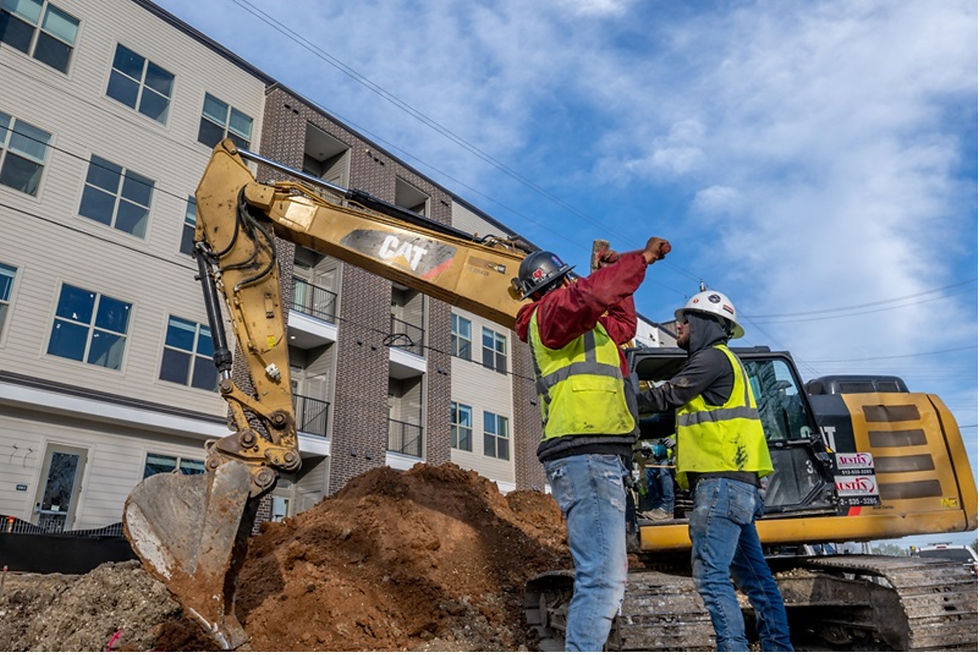Why Ground-Up Development Thrives in Soft Multifamily Markets
- Manuel (manny ) J.Herrera
- Oct 8, 2024
- 5 min read

Introduction
Investing in ground-up development during a soft market may seem risky, but it offers significant advantages that position investors for long-term success.
While challenges like falling rental prices and high vacancy rates exist, strategic new construction projects can outperform older properties and lay the groundwork for future growth.
In a multifamily real estate market experiencing falling rental prices and high vacancy rates, the idea of investing in new construction may initially seem counterintuitive. However, ground-up development presents a unique opportunity to build for the future, often positioning investors for greater success when the market rebounds. While risks are inherent, several factors make new construction an appealing option even during market downturns.
"The Strategic Edge of New Construction in a Soft Market: Modern Design and High-Quality Living"

One of the key advantages of new construction lies in its ability to deliver modern, attractive units that meet the evolving demands of renters. Properties built today often come with contemporary designs, energy-efficient systems, and advanced amenities that older buildings cannot offer. In a market where competition for tenants is fierce, these features can give new properties a significant edge. Tenants are increasingly looking for high-quality living environments, and new constructions that provide features like smart technology, sustainable building materials, and expansive communal spaces tend to attract higher-paying tenants, even in markets where overall rents are declining. This allows new developments to command premium rents, reducing the impact of broader market trends like falling rental prices.
"Tailoring New Construction for Diverse Market Demands: A Smart Approach to Mitigating Risk in Challenging Times"

Targeting the right demographic is another advantage of new construction during challenging market conditions. New developments can be tailored to meet the specific needs of various market segments, such as luxury apartments, young professionals, or affordable housing, each of which operates within its own demand cycle. In cities or regions where, rental prices might be falling, there may still be strong demand for affordable housing, especially if the existing stock is outdated or insufficient. Similarly, senior living or high-end developments may still attract steady demand due to the specific needs of these segments. By aligning the development with market trends and demographics, investors can mitigate some of the risks associated with high vacancy rates in other segments.
"Building for the Future: Leveraging Ground-Up Development During Market Downturns for Long-Term Gains"

Long-term vision plays a crucial role in the decision to pursue ground-up development in a soft market. Real estate is cyclical, and downturns do not last forever. Investing in new construction during a market through positions developers and investors to take advantage of the eventual upswing. As the market recovers, newly built properties will stand out as attractive, modern options in a landscape that may still include a large stock of aging, less desirable units. When rental rates begin to rise again and vacancies fall, these properties will already be well-positioned to capitalize on the increased demand, allowing investors to benefit from both cash flow and appreciation. New properties also tend to appreciate faster, especially when located in areas poised for future growth, such as those with emerging infrastructure or economic development projects.
"Leveraging Tax Incentives and Favorable Financing: How Ground-Up Development Thrives in Challenging Markets"

Another factor that makes ground-up development attractive is the potential for tax incentives and favorable financing terms, even during challenging market conditions. Government initiatives aimed at stimulating the economy often include grants, tax breaks, or low-interest loans for new construction projects, especially those that incorporate green building practices or affordable housing units. Developers can leverage these incentives to reduce costs and improve the overall financial feasibility of the project. Similarly, lenders may offer favorable financing terms during downturns to encourage new development, particularly if the project aligns with local economic goals or urban revitalization efforts. These financing options can reduce the risk associated with large capital outlays, helping investors maintain liquidity and flexibility during the construction phase.
"The Cost Efficiency of New Construction: Lower Maintenance and Predictable Cash Flow in Early Years"

Moreover, new construction offers the benefit of lower maintenance costs in the initial years. Unlike older properties that may require frequent repairs, retrofitting, or expensive updates to meet current building standards, newly built properties typically come with warranties on major systems and structures. This reduces unexpected expenses and allows for more predictable cash flows during the crucial lease-up period. These lower initial costs can provide a competitive edge in a market where older properties may struggle to retain tenants due to deferred maintenance or outdated amenities.
"Revitalizing Communities: How New Construction Spurs Economic Growth and Enhances Long-Term Investment Value

In addition to the direct financial benefits, new construction contributes to the broader community by creating jobs and stimulating local economies. This economic activity often fosters a more vibrant community, attracting businesses and services that further enhance the desirability of the area. Over time, these developments can help revitalize entire neighborhoods, turning previously overlooked or underdeveloped areas into thriving rental markets. For investors, being part of a community's transformation not only contributes to long-term value creation but also establishes a positive reputation, which can be leveraged in future projects.
In Summary
While market cycles play a significant role in the viability of real estate investments, understanding how to align development projects with the broader economic cycle is critical. Starting a development project during a downturn allows investors to take advantage of lower land prices, reduced competition for labor and materials, and potential government incentives. When the market begins to recover, these projects are often ready for lease-up just as demand starts to increase. Timing, therefore, becomes a strategic tool for maximizing returns.
Ultimately, successful multifamily real estate development in challenging market conditions requires thorough market research, a long-term perspective, and a willingness to adapt to the shifting dynamics of tenant demand. While ground-up development comes with its risks, particularly during periods of high vacancy and falling rents, it also offers significant rewards for investors who can weather short-term challenges for long-term gain. The key lies in creating properties that meet the needs of the future market while capitalizing on the advantages of new construction—modern design, efficient systems, and tenant-focused amenities—that older properties simply cannot provide. By doing so, investors can turn a soft market into an opportunity for growth, positioning themselves for success when the market inevitably rebounds.
The Team Members
The Syndication Firm
Krisha Young,
Business Development Director
Syndication Attorneys, PLLC
Saint Augustine, FL
The Architectural Group
Madison Kruk,
Regional Business DeveloperHumphreys & Partners Architects Orlando | St Pete | Dallas | Houston | New Orleans | Costa Mesa
The Bankers.
Fred Passmore. Acquisition loans
714 N. Island Cove Lane, Portland, OR 97217
1429 El Dorado Pkwy W, Cape Coral, FL 33914
Acquisitions
Andrew Kube. Construction loans, Renovations.
U.S. Commercial & Business Capital
Clearwater, FL
The Title Company
Heather Whitacre
Business Development / Account Manager.
Fidelity National Title
28059 US-19, Clearwater, FL 33761
The Real Estate Firm
Manny J. Herrera
Dalton Wade Real Estate Group
260 1st Ave S Suite 200, St. Petersburg, FL 33701
The Multifamily Real Estate Group LLC



Comments